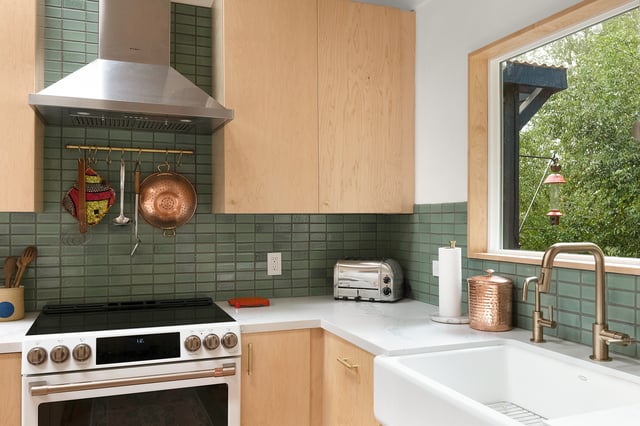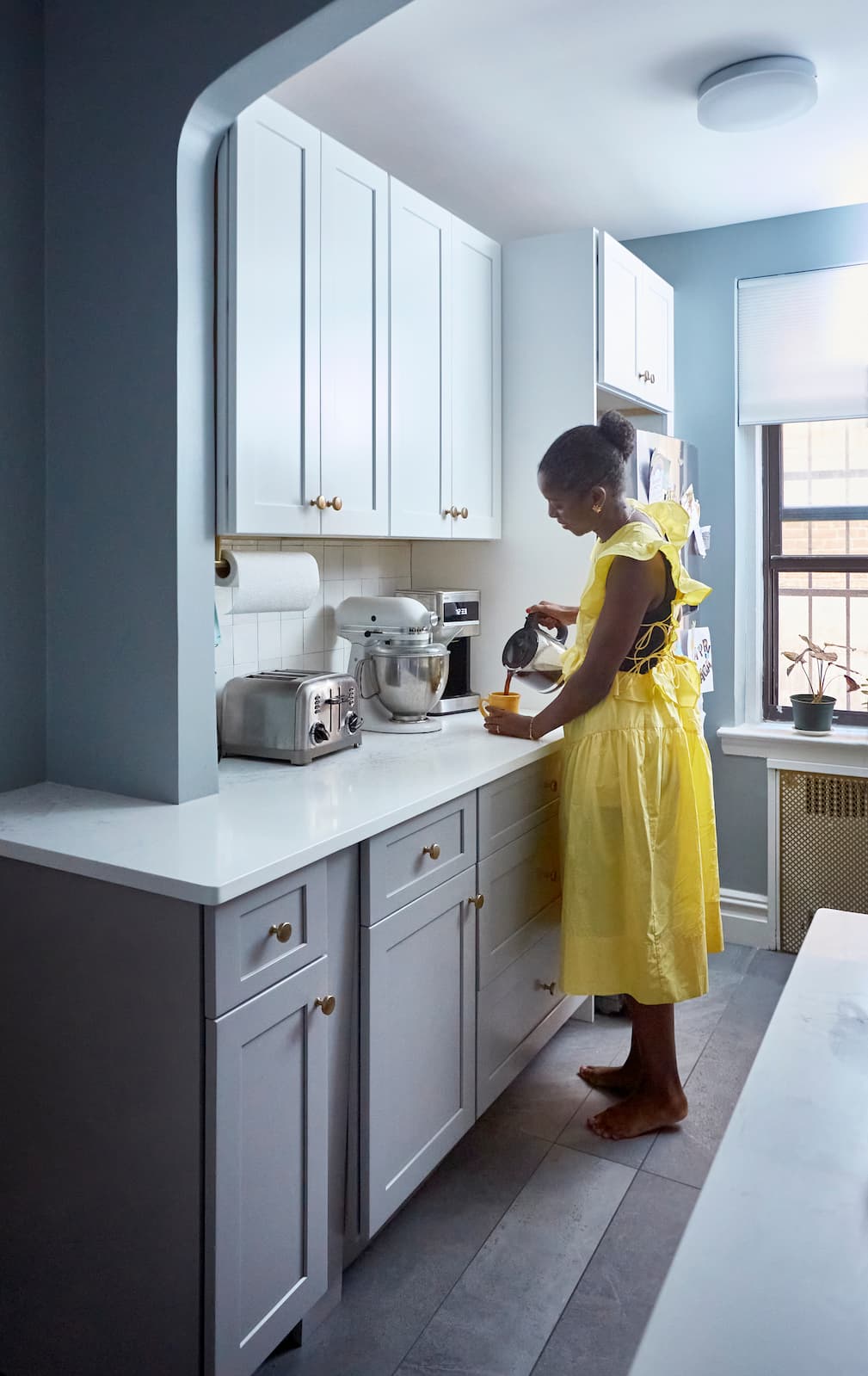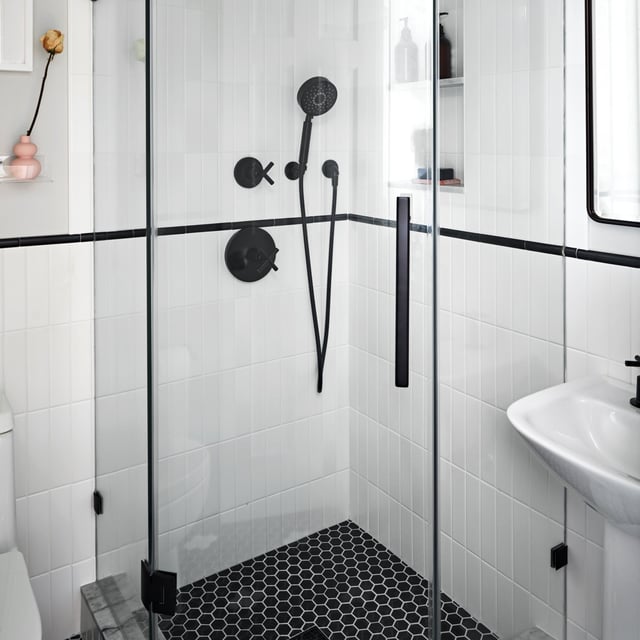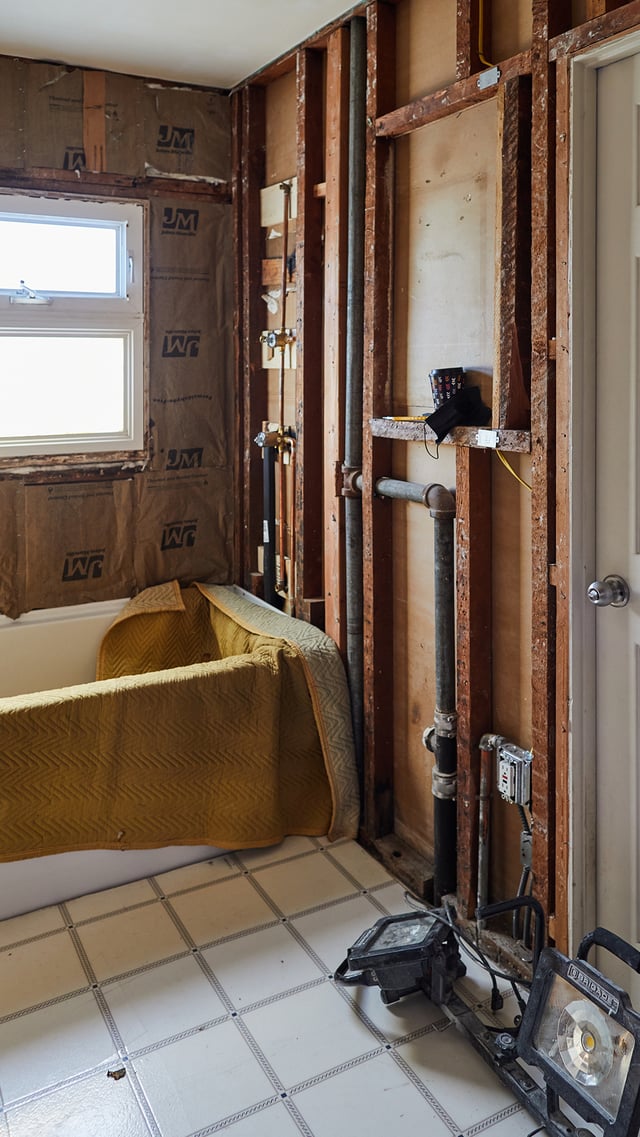
Finance
With Lower Interest Rates, Is Now a Good Time to Renovate?
09.18.2025

In This Article
Housing in 2025 is tough—prices are high, interest rates haven’t dropped much, and moving just isn’t the easy answer it used to be. So, more homeowners are staying put and putting money into their homes. Not for the fun of it, but to make them more efficient, more livable, and more valuable. ROI matters now. So do rising energy costs, weather resilience, and smarter layouts. This guide focuses on upgrades that do more than look good. The ones that actually pay off—financially and in how your home works for your life.
Some renovations just look nice. Others actually raise the value of your home. In this market, you want both. The projects that perform best are the ones that make daily life easier and appeal to what buyers are actively looking for—updated kitchens, smarter layouts, energy savings, and curb appeal. Trends matter, but so do basics. If it’s durable, efficient, and adds function, it’s probably worth your time and budget.
Aesthetic upgrades still matter—modern kitchens, updated bathrooms, and fresh finishes can absolutely catch a buyer’s eye. But looks alone aren’t enough. Today’s homeowners are placing equal weight on practicality: smart storage, efficient layouts, durable materials, and features that make the home more comfortable and cost-effective to live in.
Value also depends heavily on where you live. In warmer regions, solar or energy-efficient HVAC systems may carry more weight. In urban areas, maximizing space and improving insulation or windows can offer a stronger return. Buyer demographics play a role, too—what appeals to a growing family may differ from what’s important to remote workers or downsizing retirees.
Renovation ROI tends to fall into four broad categories:
The most impactful renovations tend to check more than one box—like a kitchen upgrade that’s both visually modern and energy smart, or an attic conversion that adds livable square footage and improves insulation.
The key is balancing what feels good to live in with what adds tangible market appeal. In the next section, we’ll look at specific renovations with the strongest ROI in 2025 and why they resonate with today’s buyers.
Kitchens are the kind of space you notice right away, whether they work or not. Maybe the layout’s cramped, maybe the appliances are from another decade, or maybe you just can’t deal with one more squeaky cabinet hinge. Whatever the reason, kitchen remodels are often the first place people start when thinking about adding value to their home.
That doesn’t always mean ripping everything out. Minor remodels—like swapping out countertops, repainting cabinets, or adding under-cabinet lighting—can go a long way. You still get the visual refresh, better function, and a big impact without gutting the space or blowing up your budget. And buyers love walking into a kitchen that feels move-in ready.
Full renovations are a bigger lift. You're talking about a new layout, plumbing moves, probably weeks without a sink. But it might be worth it if your space really doesn’t work, or you plan to stay long-term. Just know that returns are solid only if the design and finish choices match the neighborhood.
In either case, a few upgrades stand out. Quartz countertops hold up to heat, don’t stain easily, and look clean and modern. Energy-efficient appliances are a must now, not just for resale, but for your own monthly bills. And cabinet upgrades, especially soft-close hinges and deep drawers, make a kitchen feel genuinely functional.
Islands help too, if you have room. Same with open layouts, assuming they don’t make the space feel too exposed. But honestly? A smart storage system can be just as valuable.
Start with what bothers you most. Then focus on improvements that make everyday life easier, and look good doing it.
For more tips, read Kitchen Remodel ROI & Upgrades for High Resale Value.
Renovate with confidence every step of the way
Step 1: Personalize Your Renovation Plan
Step 2: Receive Quotes from Trusted Contractors
Step 3: Let Us Handle the Project Details

Bathrooms are small, but they carry weight—both in how a home functions and how it’s valued. A clean, modern, well-designed bathroom signals that the home has been cared for, and buyers notice it immediately.
Midrange remodels—like replacing fixtures, updating tile, installing a new vanity, and freshening up lighting—often deliver some of the best ROI in the home. You don’t have to go over the top. In fact, smaller changes with a thoughtful design can go further than a high-end overhaul that’s out of sync with the rest of the house.
That said, luxury touches can absolutely pay off when done right. Think dual vanities in a shared bath, heated floors in colder climates, and modern, layered lighting that helps the space feel warm and functional. These upgrades feel high-end without being extravagant.
More homeowners are also thinking ahead with aging-in-place features—walk-in showers with no thresholds, grab bars that blend into the design, or even wider doorways. These aren’t just for older buyers anymore. They’re seen as smart, future-proof upgrades that make a home more livable for everyone.
And don’t forget the powder room. It’s often the most visible bathroom in the house—and one of the easiest to upgrade. A fresh sink, mirror, or bold tile choice can leave a big impression in a small space. The same goes for secondary bathrooms. Even if they’re rarely used, buyers still expect them to feel clean, cohesive, and functional.
In a market focused on best ROI home improvements and best home renovations, bathrooms consistently deliver. Just remember: it’s not about making the space expensive—it’s about making it feel intentional. Well-planned bathroom updates help your home stand out, both in the listing photos and in person.
You don’t have to be an expert to spot a home that looks well cared for. The paint’s not peeling, the front door feels intentional, the landscaping’s neat without trying too hard. It doesn’t have to be perfect—it just has to feel welcoming.
That’s the power of curb appeal. It’s often the first thing people notice, and one of the few upgrades consistently offering a strong return on investment. Fresh exterior paint, especially on trim and entryways, can instantly lift the look of your home. And if your garage door is front-facing or takes up a lot of visual real estate, replacing it with something more modern and clean-lined can make a huge difference.
Landscaping doesn’t need to be elaborated on to be effective. In fact, simple is often better, especially when it’s low-maintenance. Using native plants that thrive in your climate cuts down on water and upkeep and resonates with sustainability-minded buyers. Clean edges, a few well-placed shrubs, and tidy ground cover can do more than an over-designed garden ever will.
Other smart improvements? Driveway resurfacing if yours is cracked or stained. Updating the front porch with better lighting or fresh railings. Even something as small as replacing your house numbers or mailbox can shift the overall impression.
These aren’t flashy renovations, but they’re effective. They make your home look cared for before anyone even steps inside, and in a competitive market, that kind of first impression can be hard to ignore.
When utility bills are high and environmental awareness is growing, it’s no surprise more homeowners are looking at ways to make their homes run smarter, not just look better. What used to be “nice to have” is now top of mind, especially in markets where buyers actively search for energy-efficient features.
Solar panels are the upgrade most people think of first. They’re a visible sign that a home is future-focused, and over time, they can seriously cut electricity costs. But plenty of other improvements don’t take up space on your roof. High-efficiency windows, tankless water heaters, and modern HVAC systems all reduce energy use in quieter, behind-the-scenes ways.
If your home is older or not well-insulated, focusing on the basics—like sealing gaps, upgrading insulation, or replacing your roof with reflective materials—can make a noticeable difference. These aren’t flashy changes, but they’re the kind that show up every month in lower heating and cooling bills.
There’s also a real financial upside: many of these upgrades qualify for federal tax credits or local rebate programs. Some homeowners recover thousands just by choosing energy-smart products or systems. It’s worth checking before you start a project—you may have more support than you realize.
And as the push toward net-zero and low-emission living continues, even small upgrades, like a smart thermostat or switching to all-electric appliances, can make your home stand out in a crowded market.
These changes aren't about chasing trends. They’re about building a home that works better for the planet, your budget, and your everyday life. And that kind of value holds up, whether you're staying or planning to sell.
Renovate now, pay later
Achieve the space you're looking for today, while financing it over time with our trusted partner.*
*Not available in NYC
Learn More
If you’re looking for more usable space without adding square footage, converting what you already have can be one of the smartest renovation moves. Basements, attics, and garages often sit underutilized—but with the right upgrades, they can become high-value living areas or even income-generating spaces.
Conversions can take many forms depending on your needs. Guest suites or in-law apartments are popular for multigenerational living or visiting family. A finished basement apartment or garage ADU (accessory dwelling unit) can bring rental income in the right market. Other homeowners turn attics into home offices, reading nooks, or even yoga studios—spaces tailored to how they live now.
But before diving into design ideas, checking a few boxes is important. Most conversions require permits, especially if adding plumbing, electrical, or separate entrances. Older garages or attics may need structural reinforcement, while basements often require waterproofing and moisture control, as well as egress windows to meet safety codes. Extending HVAC systems into these new spaces—or opting for mini-splits or radiant heating—also affects budget and comfort.
When done right, conversions can offer a strong return on investment. Basement remodels tend to recoup 60–70% of their cost, especially if they add a bedroom or bathroom. Garage conversions are a bit more regional—some buyers love the extra space, others want the parking, so resale value depends on local preferences. Attics can be tricky structurally, but often deliver great ROI when turned into usable square footage in areas where every foot counts.
Ultimately, these projects are about making your home work harder for you. Whether creating a quiet place to focus, a private spot for guests, or an income-producing rental, converting existing space is a smart way to add function and value, without building from the ground up.
You can feel it when a home’s been updated—even before you spot the big changes. The lighting is warmer. The color palette feels fresh, not trendy. The flooring flows from room to room without that awkward change at the threshold.
These kinds of design details don’t scream for attention, but absolutely influence how people experience a space. And in a competitive market, that matters.
Paint is usually the first thing to go. Off-whites, warm grays, or soft earth tones help a space feel current without locking a future buyer into a strong aesthetic. Lighting is another easy fix—older fixtures or yellowish bulbs can make a home feel dated, even if everything else is new.
Flooring plays a bigger role than most people realize. If you’re still walking on mismatched tile and worn carpet, upgrading to something consistent, like engineered wood or even a good luxury vinyl, can change the entire feel of a home. Not because it’s fancy, but because it’s seamless.
Removing popcorn ceilings. Swapping out shiny brass hardware. Replacing a clunky fan with something quieter and cleaner. These things add up.
And for homes built before open-concept was the norm? Rethinking the layout—or at least removing visual barriers—can make a space feel bigger without changing the footprint.
Turn your renovation vision into reality
Get matched with trusted contractors and start your renovation today!
Find a Contractor
Some renovations feel satisfying. Others actually move the needle when it’s time to sell. A few do both, and that’s where most homeowners focus right now.
Kitchens and bathrooms are still at the top, so it's no surprise there. These are the rooms people use daily and judge quickly. Even small things—new cabinet pulls, better lighting, a fresh backsplash—can change how a space feels. Full remodels? Great, but only if they match what the house and neighborhood can support.
Lately, energy upgrades are climbing the list. Not just for resale, but because people are tired of high bills. Swapping in better windows, a new HVAC system, even just sealing drafts can make a difference, and many of those improvements come with rebates that help soften the cost.
Ask a real estate agent or appraiser, and you’ll likely hear the same advice: keep it functional, keep it timeless, and fix the stuff behind the walls too. A stylish bath with old plumbing won’t impress anyone for long.
Some renovation regrets are easy to spot in hindsight. The goal is to catch them before they happen—and before they hit your budget or your home’s market appeal.
Over-customizing is a big one. It’s tempting to design around your favorite color or a very specific aesthetic, but if it limits future buyers’ ability to see themselves in the home, it may work against you. Design with personality, sure—but aim for flexibility.
Skipping permits or code compliance can seem like a shortcut, but it often creates long-term headaches. Unpermitted work may reduce your home’s value, delay a sale, or even require costly fixes down the line. If it needs to be inspected, get it inspected.
Another big misstep? Not inspecting before renovating. That dreamy kitchen upgrade could hit serious delays if no one noticed the old wiring or water damage hiding behind the drywall. Pre-renovation inspections aren’t glamorous, but they’re smart and can help you budget more accurately.
Finally, be selective about who you hire. Unqualified contractors or bargain-basement materials might save money upfront, but poor craftsmanship and quick fixes can cost more over time. Always ask for references, review portfolios, and confirm licensing. Renovation is an investment—treat it like one.
As homeowners continue to navigate a market shaped by rising costs, limited inventory, and shifting priorities, renovations that deliver real, lasting value matter more than ever.
If there’s one guiding principle, prioritize the projects that balance return on investment with personal enjoyment. The best renovations don’t just raise your home’s value—they make it easier to love living there.
Sustainability, buyer appeal, and smart financial planning are no longer extras—they’re essentials. And before taking on any major project, it’s worth talking with experienced professionals: real estate agents, licensed contractors, or renovation advisors who can help you make informed decisions.
Whether you’re planning to sell, stay, or simply make your space work better, thoughtful improvements are always worth the effort.
Ready to get started? Block Renovation connects you with trusted contractors, expert planners, and the tools you need to move forward with clarity and confidence. Let’s build something that lasts.

Written by Block Renovation
What are the best home renovations to increase value in 2025?
Which home improvements pay off most in today’s housing market?
What are the highest ROI home improvements for homeowners planning to sell?
How do I choose renovations that increase home value in my specific region?
Are bathroom or kitchen remodels a better investment for resale?

Renovate confidently with Block
Easily compare quotes from top quality contractors, and get peace of mind with warranty & price protections.
Thousands of homeowners have renovated with Block

4.5 Stars (100+)

4.7 Stars (100+)

4.5 Stars (75+)

Finance
With Lower Interest Rates, Is Now a Good Time to Renovate?
09.18.2025

Finance
Smart Ways to Finance a Home Addition
09.18.2025

Contractors
Half Bathroom to Full Conversion: Costs, Permits & Designs
08.02.2025

Process
Gutting a Bathroom: What It Entails, Costs & Timeline
07.15.2025

Finance
What’s the Best Way to Pay for Home Renovations: Savings or Financing?
05.23.2025
Renovate confidently